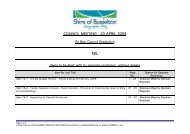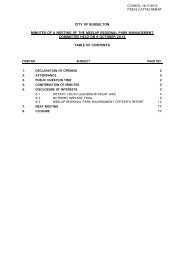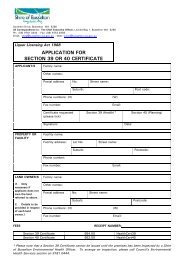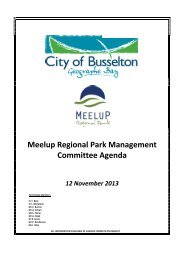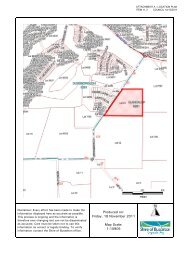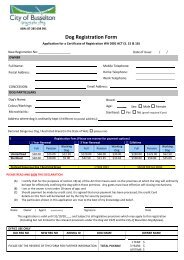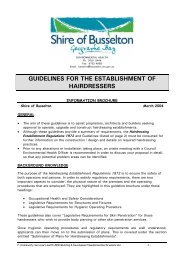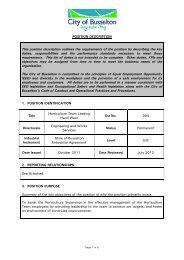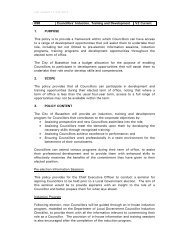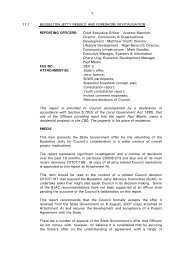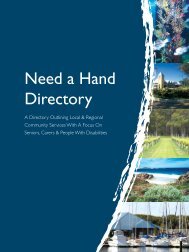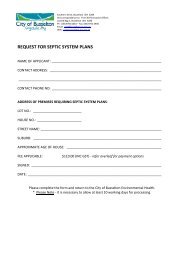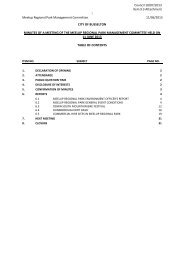Draft Reflective Building Materials Officers Report ... - City of Busselton
Draft Reflective Building Materials Officers Report ... - City of Busselton
Draft Reflective Building Materials Officers Report ... - City of Busselton
Create successful ePaper yourself
Turn your PDF publications into a flip-book with our unique Google optimized e-Paper software.
Council 17 10/02/201013.2 REFLECTIVE BUILDING MATERIALS POLICY: CONSIDERATION FOR ADOPTIONFOR COMMUNITY CONSULTATIONSUBJECT INDEX: Local Planning PoliciesAPPLICATION NUMBER: N/ASTRATEGIC INITIATIVE: 2.4.5 Develop a new Town Planning SchemeTo Provide For The Lifestyle We Cherish AndProtectBUSINESS UNIT: Strategic Planning and SustainabilitySERVICE:Strategic Land-Use PlanningREPORTING OFFICER: Senior Land-Use Planner (Policy) - David BrashAUTHORISING OFFICER: Director, Lifestyle Development - Nigel Bancr<strong>of</strong>tDATE OF COMPLETION: 10 March 2010VOTING REQUIREMENT: Simple MajorityPROPOSAL:Adoption <strong>of</strong> a draft revised <strong>Reflective</strong> <strong>Building</strong><strong>Materials</strong> Policy for community consultationLOT SIZE:N/AZONE:AllPOLICIES:State Planning Policy 3.1 Residential DesignCodes (Variation 1)SPP No. 6.1 (1998) - Leeuwin Naturaliste RidgePolicyUse <strong>of</strong> <strong>Reflective</strong> <strong>Building</strong> <strong>Materials</strong> (2003)<strong>Building</strong> Code <strong>of</strong> Australia (2009)ATTACHMENT(S): A- Schedule <strong>of</strong> Submissions.PRÉCISA directions paper on a review <strong>of</strong> the Use <strong>of</strong> <strong>Reflective</strong> <strong>Building</strong> <strong>Materials</strong> Policywas endorsed by the Council on the 27 May, 2009. The conclusion <strong>of</strong> thedirection paper was that the Council is justified in seeking to control the use <strong>of</strong>reflective building materials where the use <strong>of</strong> these materials can lead to problems<strong>of</strong> specular glare and landscape impact.The directions paper was advertised for community consultation and attracted five(5) submissions. The comments from a number <strong>of</strong> the submitters challenge theconclusions reached in the directions paper, particularly with regard to the broadpolicy approach as well as promoting the thermal and energy efficiency <strong>of</strong> lightcoloured ro<strong>of</strong>s.A draft revised <strong>Reflective</strong> <strong>Building</strong> <strong>Materials</strong> Policy, which reflects the outcomes <strong>of</strong>the community consultation and provides increased flexibility and clarity in respectto the use <strong>of</strong> these materials in residential areas, has been prepared by staff forconsideration by the Council for community consultation.It is recommended that the Council adopts the draft policy for the purposes <strong>of</strong>community consultation.
Council 20 10/02/2010POLICY IMPLICATIONSThe draft policy forms part <strong>of</strong> the <strong>of</strong>ficer recommendation. It differs from thecurrent policy in that it deletes reference to “Solar Reflectance” as a measure <strong>of</strong>light emittance from various products and instead controls materials according toa classification provided by BlueScope Steel Australia Ltd which is based upon the<strong>Building</strong> Code <strong>of</strong> Australia (BCA).The problem with retaining the use <strong>of</strong> Solar Reflectance as a measure <strong>of</strong> glare andlight emissivity is that because most building materials are not rated by theamount <strong>of</strong> visible light that they emit, (i.e. their light reflectance value), policymeasures which rely upon the control <strong>of</strong> the solar reflectance value <strong>of</strong> materials(which is a measure <strong>of</strong> energy emittance) will be ineffective in controlling theextent to which the problem occurs. The Council’s current policy is based solelyon a solar reflectance value <strong>of</strong> 50% and not only controls a very narrow range <strong>of</strong>building products but is arguably unfair in that it only targets metal ro<strong>of</strong>ingproducts.Therefore this draft version <strong>of</strong> the policy seeks to eliminate the risk <strong>of</strong> problems bycontrolling certain materials which are known to carry a high risk <strong>of</strong> glare andreflectance.The policy also recognises that the use <strong>of</strong> reflective ro<strong>of</strong>ing materials may bepermissible in some instances where the proponent can demonstrate that the use<strong>of</strong> the materials, the specific design and the circumstances <strong>of</strong> the proposal will notresult in a negative amenity or landscape impact.The draft policy removes the need for the Shire to issue approval for the use <strong>of</strong>reflective wall cladding within town sites making it easier for proponents to gainapprovals for use <strong>of</strong> these materials. Other minor exemptions from the need toobtain approval are granted under the draft policy (Refer to Table 1 in the draftpolicy). These policy exemptions are warranted due to the low risks associatedwith the use <strong>of</strong> these materials in providing increased certainty on when anapplication is required.The current policy can be sourced from the Shire’s webpage.FINANCIAL IMPLICATIONSThe direct financial implications <strong>of</strong> the recommendations <strong>of</strong> this report are limitedto the costs associated with undertaking the review <strong>of</strong> the policy and presentingthat reviewed document to the Council for consideration for adoption. Those costswill be met using existing, budgeted resources.STRATEGIC IMPLICATIONSThe proposal is considered to be consistent with the relevant Strategic Objectives<strong>of</strong> the Shire <strong>of</strong> <strong>Busselton</strong>’s Strategic Plan 2006-2011:
Council 21 10/02/20102.1 To develop and maintain the Shire’s assets and built environment tomaximize public benefit now and into the future.2.3 Ensure development <strong>of</strong> the Shire recognises the unique character <strong>of</strong> theregion and successfully balances the pressures <strong>of</strong> development and theprotection <strong>of</strong> our rural and coastal amenities.The draft policy is considered to be consistent with other broader objectivescontained in the Strategic Plan2006-2011.OFFICER COMMENTThe <strong>of</strong>ficer’s response to the key issues raised in the submissions is as follows:Conflict with the Energy efficiency provisions <strong>of</strong> the BCA 2010.BlueScope Steel Ltd is concerned that policies that seek to control visual glaremay be at variance with good environmental policy.<strong>Draft</strong> Energy Efficiency changes to Part 3.12 <strong>of</strong> the BCA were circulated by theAustralian <strong>Building</strong> Codes Board in August 2009. The draft changes includeinsulation concessions (<strong>of</strong> sorts) in both Volumes <strong>of</strong> the BCA, for light colouredro<strong>of</strong>s. The concessions are based on modelling outcomes - comparing low solarabsorption ro<strong>of</strong>ing to high in different modelling scenarios, where the finding isthat less insulation is needed under light coloured ro<strong>of</strong>s (depending on climatezones). <strong>Busselton</strong> is a cooler temperate climate and therefore does not demandthe degree <strong>of</strong> thermal insulation to buildings (particularly the underside <strong>of</strong> ro<strong>of</strong>s)which hotter less temperate climates demand. This in turn can reduce dependenceupon reverse cycle air-conditioning and therefore energy demand.Following the close <strong>of</strong> advertising staff undertook additional consultation with theAustralian <strong>Building</strong> Codes Board and BlueScope Steel Ltd on the issues <strong>of</strong> thermaland energy efficiency <strong>of</strong> light coloured ro<strong>of</strong>s in the Shire <strong>of</strong> <strong>Busselton</strong>. TheAustralian <strong>Building</strong> Code Board has advised that the thermal performance forro<strong>of</strong>ing and insulation in the BCA is optional so this should not restrict theobjectives <strong>of</strong> a local planning policy to any great extent, and that the Shire’spolicy does not conflict with the BCA as claimed.To explain this further a choice <strong>of</strong> metal ro<strong>of</strong> with a lower absorptive value, whileresulting in less insulation to the underside <strong>of</strong> the airspace will not result in abetter thermal performance <strong>of</strong> the building. This is because the BCA sets athermal performance target for the whole building which must be met bysatisfying the building fabric requirements <strong>of</strong> 3.12.1.2 <strong>of</strong> the BCA and insulationto the underside <strong>of</strong> ro<strong>of</strong>s.As the draft BCA changes propose to mandate an R5.3 insulation value for allclimatic zones (increasing from R 3.2 for the Shire <strong>of</strong> <strong>Busselton</strong>) the importancegiven to lighter coloured metal ro<strong>of</strong>s is small by comparison (9.4% <strong>of</strong> the total Rvalue for the ro<strong>of</strong>) and any loss <strong>of</strong> thermal performance through darker colouredro<strong>of</strong>s can be compensated through additional insulation in the ro<strong>of</strong> under-space.
Council 22 10/02/2010A Case by Case Policy ApproachSome submissions recommended that the Shire adopts a case by case or meritbased approach to the policy. Staff, however, are <strong>of</strong> the view that both thecurrent and the draft policy are largely merit based as they permit applications forthe use <strong>of</strong> reflective building materials to be assessed against the policy criteria.What the policy does not try to achieve, though, is a codified set <strong>of</strong> rules for theuse <strong>of</strong> reflective building materials.The difficulty with trying to codify a set <strong>of</strong> rules for the use <strong>of</strong> certain materials(other than through controlling the reflectivity <strong>of</strong> the material or requiring anexpensive study) is that each property/proposal is different in terms <strong>of</strong> its context,height, adjoining development, elevation in the landscape, degree <strong>of</strong> risk <strong>of</strong> glaredue to orientation, ro<strong>of</strong> pitch, shading, vegetation etc.For this reason it is not yet possible to codify a set <strong>of</strong> parameters/assessmentcriteria which, if met, would enable a ‘deemed to comply’ application to beapproved in all situations and allow the use <strong>of</strong> more energy efficient materialsirrespective <strong>of</strong> their light reflectance value.This is why most reflective building materials policies across Australia target theproduct type, almost to the point <strong>of</strong> prohibition as opposed to codifying designparameters. The <strong>City</strong> <strong>of</strong> Subiaco has attempted to codify a set <strong>of</strong> designparameters for reflective ro<strong>of</strong>s, however from discussions with <strong>of</strong>ficers at the <strong>City</strong>it is apparent that the Subiaco policy approach is still very subjective, results indelays to approvals and can draw the <strong>City</strong> into neighbour disputes overreflectance issues. To work effectively, <strong>of</strong>ficers would need to be trained in thescience <strong>of</strong> specular glare or reflectance.For these reasons staff have formed the view that the most appropriate policyapproach is:· to preclude certain materials that have been classified according to theirlightness and are known to create risks for glare and light reflectance;· set broad reflectance limits for products which have not yet been classifiedaccording to their lightness but which are known to create problems incircumstances such as use for ro<strong>of</strong>ing; and· permit all products which carry a low risk <strong>of</strong> glare or reflectance by virtue <strong>of</strong>their physical characteristics or the locations in which they are proposed.Some recognition <strong>of</strong> criteria for the use <strong>of</strong> certain materials is also included in thedraft policy. For instance the draft policy allows concessions for reflective ro<strong>of</strong>ingmaterials on flat or low slope skillion ro<strong>of</strong> styles where the impact <strong>of</strong> the glare isdemonstrated to be minimal.Solar and Light Reflectance Values.It is agreed that the Solar Reflectance Table at Schedule 1 <strong>of</strong> the current policydoes not accurately predict the extent <strong>of</strong> light reflectance from various metalbuilding materials. This is because solar reflectance (the measure used within
Council 23 10/02/2010Schedule 1 <strong>of</strong> the current policy) relates to the total spectrum <strong>of</strong> solar energyemitted (i.e including light energy in the non visible parts <strong>of</strong> the spectrum such asinfra-red and Ultra-Violet light) from a surface and not the reflected visible light.As a result it is proposed to replace the solar reflectance table in the current policywith a new table that accurately depicts the light reflectance and solar absorptionproperties <strong>of</strong> various building products in accordance with information provided byBlueScope Steel Ltd.CONCLUSIONThe Directions Paper was advertised for community consultation and a range <strong>of</strong>comments were received. These comments have been reviewed. A <strong>Draft</strong><strong>Reflective</strong> <strong>Building</strong> <strong>Materials</strong> Policy has been prepared, which follows the directiongiven in the Council’s resolution, and responds to the comments received duringthe consultation process.The adoption <strong>of</strong> the draft policy for consultation will enable further feedback onthe structure and contents <strong>of</strong> the policy to be considered, prior to the Councilconsidering the matter again prior to final approval.OptionsThe various options available to the Council in adopting or not adopting a policyposition on the use <strong>of</strong> reflective ro<strong>of</strong>ing and materials across the Shire have largelybeen addressed through the Directions Paper, which the Council endorsed for thepurposes <strong>of</strong> guiding the review <strong>of</strong> the current Policy.The <strong>of</strong>ficer recommendation reflects the findings <strong>of</strong> the research into the impacts<strong>of</strong> controlling reflective building materials across the Shire and within otherjurisdictions as well as feedback from preliminary consultation. The findings fromthe research were that it was in the public interest for the Council to control theuse <strong>of</strong> reflective building materials in built up areas through a local planning policy.This is supported by conclusions reached by merit review tribunals. Also as thetools required for planners to assess applications on an individual basis do notcurrently exist, a broad policy approach to preclude certain materials in the lightand very light product range under the BCA is a valid planning response.The draft policy has been prepared to minimise productivity impacts and avoidapproval delays and cost implications for applicants.However if the Council chooses not to adopt the <strong>of</strong>ficer’s recommendation, theother options available could be to:A. Retain the current policy unchanged.The difficulties with retaining the current policy unchanged have been outlinedin the report. The difficulties with the current policy are that it uses a measure<strong>of</strong> reflectivity that is unrelated to the light reflectance <strong>of</strong> the material. Also thecurrent Policy precludes bare and coloured metal products on walls andreflective materials on low sloping ro<strong>of</strong>s in the residential areas. The draft
Council 24 10/02/2010policy does not seek to control these materials as the finding is that the risk <strong>of</strong>these materials in-situ is quite low.B. Only control the materials if a problem occurs by requiring a retrospective workorder to rectify the problem.Some difficulties with this approach relate to the ability <strong>of</strong> the Shire to enforceits own policy. Prevention may be better than cure, particularly when aproposal will clearly lead to problems and/or likelihood <strong>of</strong> neighbouringcomplaints.C. Do not seek to control reflective materials across the Shire.This would be contrary to the findings <strong>of</strong> the research, which concluded that itwas in the public interest for the Council to control specular glare and visualreflectance in specific areas <strong>of</strong> the Shire. It may also conflict with StatePlanning Policy 6.1 which seeks to protect identifiable landscape andsettlement character through land use controls.D. Refer to the Policy and Legislation CommitteeThis is not recommended as the draft policy is not a significant departure fromthe Council’s current Use <strong>of</strong> <strong>Reflective</strong> <strong>Building</strong> <strong>Materials</strong> policy; the changesto the current policy are minor, and the draft policy is consistent with theCouncil’s earlier direction on the review <strong>of</strong> the policy.TIMELINE FOR IMPLEMENTATION OF OFFICER RECOMMENDATIONThe <strong>of</strong>ficer recommendation including the advertising <strong>of</strong> the Policy in the localpress will be implemented within one month <strong>of</strong> adoption <strong>of</strong> the OfficerRecommendation.OFFICER RECOMMENDATIONThat the Council determines that the draft policy is consistent with the Schemeand State Planning Policies, and adopts the draft revised <strong>Reflective</strong> <strong>Building</strong><strong>Materials</strong> Policy pursuant to Clause 103, <strong>of</strong> District Town Planning Scheme No.20 for the purposes <strong>of</strong> community consultation as follows:REFLECTIVE BUILDING MATERIALS POLICYBACKGROUNDCouncil considers that ZINCALUME®, some COLORBOND® products and other building materialswith reflective surfaces can create amenity problems arising from sunlight reflection and glare.However because most building materials are not rated by the amount <strong>of</strong> visible light that theyemit, (i.e. their light reflectance value), policy measures which rely upon the control <strong>of</strong> the solarreflectance value <strong>of</strong> materials will be ineffective in controlling the extent to which the problemoccurs. The earlier version <strong>of</strong> this policy was based solely on a solar reflectance value <strong>of</strong> 50%and only controlled metal ro<strong>of</strong>ing products within a very limited range.
Council 7 10/02/2010the development shall significantly detract from the visual amenity <strong>of</strong> the area andwhether conditions should be imposed in relation to the use <strong>of</strong> prescribed materials.1. OBJECTIVES1.1 To protect the amenity <strong>of</strong> residential living environments by controlling the use <strong>of</strong>reflective building materials.1.2 To preserve the visual amenity and rural / scenic character <strong>of</strong> areas <strong>of</strong> landscapevalue from the potential visual detraction <strong>of</strong> reflective building materials.1.3 To acknowledge that the <strong>Building</strong> Code <strong>of</strong> Australia (BCA) is the controllinglegislation for matters <strong>of</strong> building energy efficiency, and that the use <strong>of</strong> lightercoloured ro<strong>of</strong>ing materials can contribute to improved building energy efficiency.1.4 To ensure that in instances where discretion <strong>of</strong> the Shire is required to approve theuse <strong>of</strong> reflective building materials, that this only occurs when an assessment hasbeen undertaken in relation to the potential visual detraction and amenity impactsarising from sunlight reflection and glare.1.5 To assist in the determination <strong>of</strong> matters to be considered pursuant to clause27(4)(a) and 27(3) <strong>of</strong> the Scheme.2. DEFINITIONS<strong>Reflective</strong> <strong>Building</strong> Material - means any building material with the potential to createspecular glare or visual detraction <strong>of</strong> the scenic or landscape character <strong>of</strong> the Shire whenin-situ and includes· Zincalume ® (including any zinc or Zinc-Aluminium coated sheet or polishedmetal),· Light and Very Light building materials as outlined Schedule 1 <strong>of</strong> this policy,· stainless steel,· copper(where sealed against oxidation),· glazed terra cotta tiles (irrespective <strong>of</strong> colour),· High Gloss painted finishes with a light reflectance and/or chroma valueexceeding 50%,· Large expanses <strong>of</strong> tinted or clear glass or Perspex ® (transparent and translucentacrylic).Landscape Value Area - means the Landscape Value Areas depicted on the operativeTown Planning Scheme Map.Light <strong>Building</strong> <strong>Materials</strong> – means those proprietary products listed as such in Schedule1, <strong>of</strong> this policy.Travel Route Corridor - means Land within 400m <strong>of</strong> any road identified as a ‘TravelRoute Corridor’ pursuant to State Planning Policy No. 6.1: Leeuwin-Naturaliste RidgePolicy (LNRSPP), including:* Metricup Road
Council 8 10/02/2010* Metricup Yelverton Road* Wildwood Road* Vasse Yallingup Siding Road* Commonage Road* Chain Avenue(Note that the policy already applies where travel route corridors areincluded in a ‘Landscape Value’ Area pursuant to the Scheme. The abovetravel route corridors are listed as examples as they are wholly or partlyexcluded from this area designation).· Land within 200m <strong>of</strong> Bussell Highway (where outside the area <strong>of</strong> theLNRSPP), <strong>Busselton</strong> Bypass or Vasse Highway.The inclusion <strong>of</strong> land within 400m <strong>of</strong> a road identified as a travel route corridor isbased on the scaled width <strong>of</strong> these corridors on the Landscape Classes Mappursuant to the LNRSPP.The inclusion <strong>of</strong> land within 200m <strong>of</strong> an important regional highway is half thatapplied to identified travel route corridors given that these are general ruralcharacter areas only.Very Light <strong>Building</strong> <strong>Materials</strong> – means those proprietary products listed as such inSchedule 1, <strong>of</strong> this policy.Zincalume ® - means the proprietary product produced by BlueScope Steel Australia andincludes any Zinc or Zinc-Aluminium coated sheet or polished metal.3. POLICY PROVISIONS AND ASSESSMENT CRITERIA3.1 The control <strong>of</strong> reflective materials within Landscape Value Areas and Travel RouteCorridors.3.1.1 The use <strong>of</strong> the following reflective materials is not permitted within theLandscape Value Area and the Travel Route Corridors as defined by the Schemeand this policy, unless their use is approved in accordance with clause 3.1.2 <strong>of</strong> thisPolicy or it is used in a vertical installation <strong>of</strong> no greater than 18m² in cumulativearea:· Zincalume ® (including any zinc or Zinc-Aluminium coated sheet or polishedmetal),· Light and Very Light building materials· stainless steel,· copper(where sealed against oxidation),· glazed terra cotta tiles (irrespective <strong>of</strong> colour),· High Gloss painted finishes with a light reflectance and/or chroma valueexceeding 50%,· Large expanses <strong>of</strong> tinted or clear glass or Perspex ® (transparent and translucentacrylic).
Council 9 10/02/20103.1.2 The use <strong>of</strong> any <strong>of</strong> the abovementioned reflective materials (clause 3.1.1) may bepermitted at the discretion <strong>of</strong> the Council (subject to submission <strong>of</strong> a formaldevelopment application) only where it is demonstrated by the applicant that theparticular proposal satisfies all <strong>of</strong> the assessment criteria relevant to the specificareas outlined below:· The owner <strong>of</strong> any surrounding / adjoining lot that may be affected by theuse <strong>of</strong> the reflective material has been consulted and their comments havebeen considered in the determination <strong>of</strong> the application.(Where the comments <strong>of</strong> a potentially affected landowner are not providedby the applicant, Council shall refer the application to the landowners for aminimum period <strong>of</strong> 14 days. Any objections must be based on reasonablegrounds and supported by written explanation).· The use <strong>of</strong> the reflective material will not detrimentally affect the landscapevalue, visual amenity or rural / scenic character <strong>of</strong> the area.· The colour choice (including the chroma or brightness <strong>of</strong> the colour 1 ) and thelight reflectance from the proposal is such that it will not be vivid orprominent but will be visually recessive in the landscape.· Clause 27 <strong>of</strong> the Scheme (if applicable)· The use <strong>of</strong> the reflective material will not detrimentally affect, or be visuallyprominent from, the rural / scenic view-scapes <strong>of</strong> a travel route corridor ormajor highway.· There is sufficient vegetation (which is protected in perpetuity) or othernatural feature to screen the reflective material, so that it is obscured fromview and will not be inconsistent with the above assessment criteria.3.2 The control <strong>of</strong> reflective ro<strong>of</strong>ing materials within the Residential, Tourist, SpecialPurpose and Rural Residential zones.3.2.1 The use <strong>of</strong> Zincalume ® ro<strong>of</strong>s and Very Light ro<strong>of</strong>s is not permitted within theResidential, Tourist, Special Purpose, or Rural Residential zones, as defined bythe Scheme, unless their use is approved in accordance with clause 3.2.4 <strong>of</strong> thisPolicy.3.2.2 For the purposes <strong>of</strong> provision 3.2, the term Residential zones includes all landzoned/controlled under the Scheme for the purpose <strong>of</strong> residential development oruse and includes those residential components <strong>of</strong> the Vasse Development Zone,Yalyalup Development zone and other Development Zones.3.2.3 Provision 3.2 will prevail to the extent <strong>of</strong> any conflict between the requirementsoutlined in provision 3.1 and the requirements outlined in provision 3.2.1An example <strong>of</strong> chroma measurement can be found at
Council 10 10/02/20103.2.4 The use <strong>of</strong> any Zincalume ® and Very Light ro<strong>of</strong>s within the zones described at3.2.1, may be permitted at the discretion <strong>of</strong> the Shire (subject to submission <strong>of</strong>a formal development application) only where it is demonstrated by the applicantthat the particular proposal satisfies all <strong>of</strong> the assessment criteria relevant to thespecific areas outlined below:· The owner <strong>of</strong> any surrounding / adjoining lot that may be affected by theuse <strong>of</strong> the reflective material has been consulted and their comments havebeen considered in the determination <strong>of</strong> the application.(Where the comments <strong>of</strong> a potentially affected landowner are not providedby the applicant, Council shall refer the application to the landowners for aminimum period <strong>of</strong> 14 days. Any objections must be based on reasonablegrounds and supported by written explanation).· The reflective material will not cause a specular glare impact on adjoining oradjacent “Residential Zoned” land.· The reflective material will not be visually prominent from a main road orpublic place <strong>of</strong> public use or congregation.· The reflective material will not be detrimental to the natural amenity <strong>of</strong> thesurrounding area particularly where the proposal adjoins or could beprominent from any estuary, wetland or natural reserve area.· The reflective material will not create a problem <strong>of</strong> specular glare or hazardfor an adjoining property at particular times <strong>of</strong> the day or year, particularlyfor property located to the south <strong>of</strong> the proposal.· There is sufficient vegetation, shade sails, buildings, or other structures toscreen the reflective material, so that it is obscured from view and will notbe inconsistent with the above assessment criteria; or· The building ro<strong>of</strong> design either incorporates a very small area <strong>of</strong> reflectivero<strong>of</strong>ing material or is a flat, very low slope or skillion design which due to itsdesign and context will not create a problem <strong>of</strong> specular glare for anadjoining property(s).3.3 The Shire may exercise its discretion to permit the use <strong>of</strong> reflective buildingmaterials on buildings <strong>of</strong> State and local heritage significance (i.e. buildings listedon the State Heritage Register or Shire <strong>of</strong> <strong>Busselton</strong> Municipal Inventory <strong>of</strong>Heritage Places), or otherwise where there is a need to maintain the architecturalintegrity <strong>of</strong> existing buildings that incorporate such materials.4. APPLICATION REQUIREMENTSApplicants seeking to use reflective materials under 3.1.2 or 3.2.4 should support theirapplication with a site plan, photographs from within the site and local view-scapes,architectural details and any other information necessary to address assessment criteriaoutlined in this policy.
Council 11 10/02/2010Applicants should note that it is their responsibility to justify use <strong>of</strong> reflective buildingmaterials in the circumstances <strong>of</strong> their particular case. Failure to submit appropriatesupporting information will disadvantage the proper assessment <strong>of</strong> the application.SCHEDULE 1COLOUR CLASSIFICATION IN ACCORDANCE WITH THE BCAThe <strong>Building</strong> Code <strong>of</strong> Australia (BCA) has classified ro<strong>of</strong> colour on the basis <strong>of</strong> theirsolar absorptance, referred herein as very light, light and dark.Colour Solar Absorptance ClassificationClassic Cream 0.31* VLSurfmist® 0.318* VLPaperbark® 0.421 LEvening Haze® 0.427 LShale Grey 0.433 LSandbank® 0.455 LDune® 0.466 LWindspray® 0.584 DPale Eucalypt® 0.597 DBushland® 0.619 DHeadland® 0.632 DWilderness® 0.651 DJasper® 0.682 DManor Red® 0.688 DWoodland Grey® 0.706 DL<strong>of</strong>t® 0.711 DMonument® 0.732 DIronstone® 0.743 DCottage Green® 0.746 DDeep Ocean® 0.749 DKey: VL-Very Light: L-Light: D-DarkNote: These values do not relate to the COLORBOND® Ultra or Stainless steel ranges.Please note, these readings are for standard COLORBOND® colours incorporatingThermatech® technology.CARRIED 11/0(EN BLOC)



